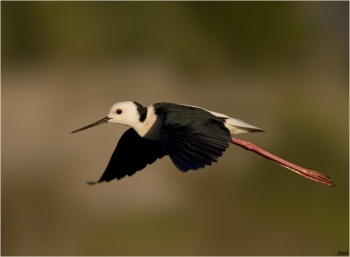Alternative names: Australian Stilt; White-headed Stilt
- Himantopus leucocephalus
Identification
Length: 35–40 cm (13¾-15¾ in)
- Greenish-black back of the neck
- Black back, scapulars and wings also underwings
- Remainder of body white
- Smoky grey tail
- Red eyes
- Black bill (may be horn-coloured at the tip)
- Pink legs and feet
Females have slightly longer, more upturned bills than males and duller, less shiny black. Juveniles have gray wash on head and neck, dull pink legs and dark brown back and wings.
Similar Species
Juvenile Black Stilt may be mistaken for Pied Stilt. Juvenile Black Stilts usually have some black on their underparts between the legs and the tail, even if restricted to the flanks becoming more extensive after their first moult. Any stilt with extensive black on the hind belly and white foreneck likely to be an immature Black Stilt. Stilts with irregular or mottled black markings and black foreneck are likely to be hybrids between Black and Pied stilts.
Distribution
Breeds from Indonesia to Australia and New Zealand; winters to Philippines.
Taxonomy
This is a monotypic species[1].

Photo © by the late Rookery
West Shore Wildlife Reserve, Napier, New Zealand, 27 January 2017
Nomenclature
A lot of the confusion over which name to use for this species comes from the disagreement over how many species of Stilts are found in the world. Opus inherited from Sibley and Monroe the view that six species exist, a view that is shared with Clements, while Howard and More only seems to recognize one species: Black-winged Stilt = Himantopus himantopus. The confusion does not get less from the fact that Black-winged Stilt = Himantopus himantopus is still in use, now meaning the stilt in Africa, Europe, and Asia. Often called Black-winged Stilt (which is the name for Himantopus himantopus) in Australia causing some confusion. Has also sometimes been called Australian Stilt or White-headed Stilt (another name sometimes used for Himantopus himantopus).
Habitat
Lake margins, wet pasture, and riverbeds. Flocks at lakes and estuaries when not breeding.
Behaviour
Diet
They eat a wide variety of small aquatic vertebrates and invertebrates; also seeds are occasionally eaten.
Breeding
Breeding sites occupied starting in June-July. They usually breed in colonies of about 15 pairs but large colonies may have up to 100 pairs. Both parents build the nest on the ground near water, often in a damp situation. Nest made of mud, vegetation and debris from nearby. Both adults incubate the 3-4 eggs, which hatch after c.25 days. The chicks leave the nest when 28-32 days old. When hatched they are brooded by their parents but find their own food. The parents continue to care for the young who remain with them even during the end of season migration.
Vocalisation
Most common calls are high pitched yapping alarm calls. A less strident version is used as a contact call, including by flocks flying at night.
References
- Clements, J. F., T. S. Schulenberg, M. J. Iliff, D. Roberson, T. A. Fredericks, B. L. Sullivan, and C. L. Wood. 2018. The eBird/Clements checklist of birds of the world: v2018. Downloaded from http://www.birds.cornell.edu/clementschecklist/download/
- Pierce, R.J., Kirwan, G.M. & Boesman, P. (2017). Black-winged Stilt (Himantopus himantopus). In: del Hoyo, J., Elliott, A., Sargatal, J., Christie, D.A. & de Juana, E. (eds.). Handbook of the Birds of the World Alive. Lynx Edicions, Barcelona. (retrieved from http://www.hbw.com/node/53759 on 21 March 2017).
- Adams, R. 2013. Pied stilt. In Miskelly, C.M. (ed.) New Zealand Birds Online. http://www.nzbirdsonline.org.nz
- Marchant, S.; Higgins, P.J. (eds) 1993. Handbook of Australian, New Zealand and Antarctic birds. Vol. 2, raptors to lapwings. Oxford University Press, Melbourne.
Recommended Citation
- BirdForum Opus contributors. (2024) Pied Stilt. In: BirdForum, the forum for wild birds and birding. Retrieved 24 April 2024 from https://www.birdforum.net/opus/Pied_Stilt
External Links
GSearch checked for 2020 platform.1





